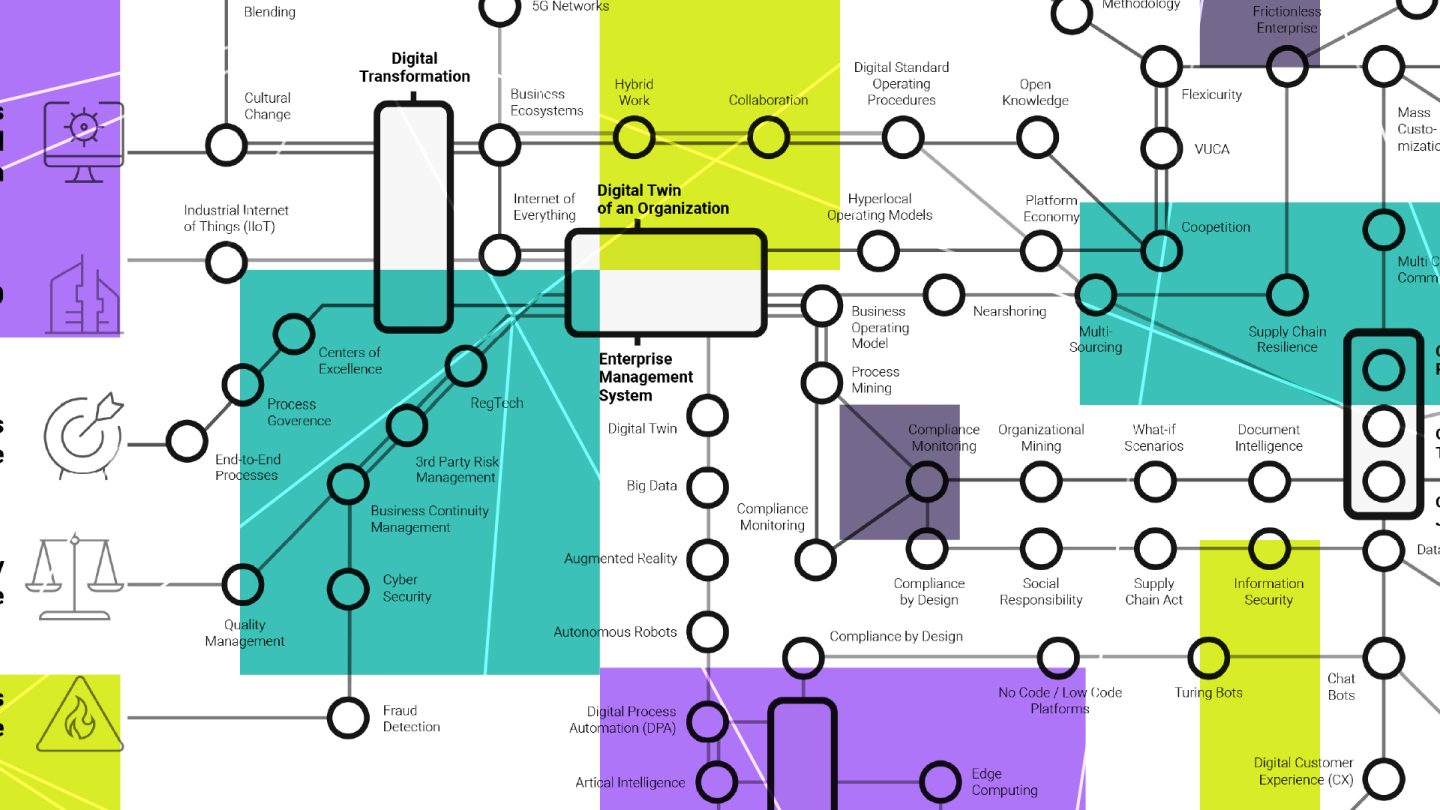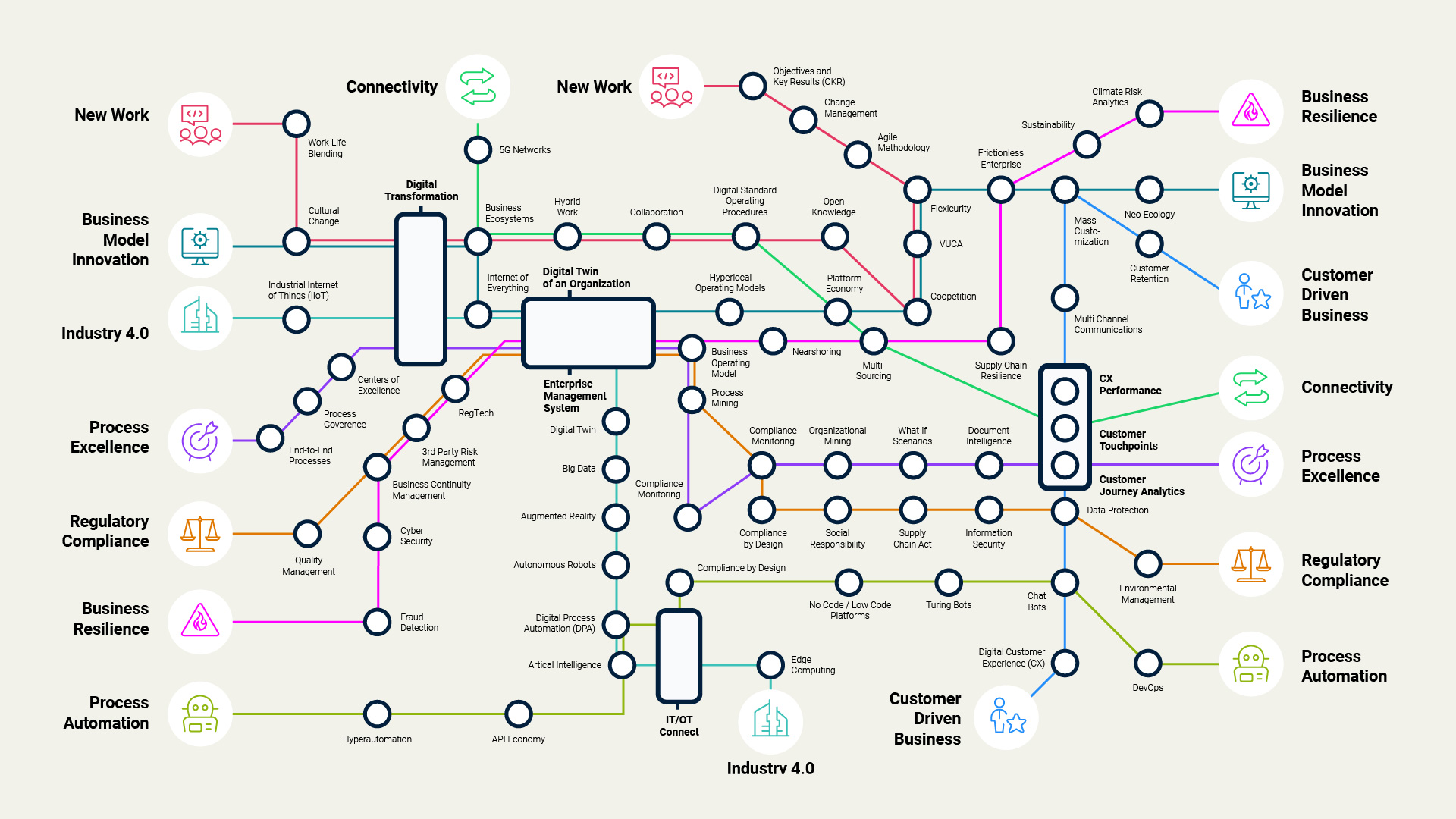Follow the trend map to business transformation
See our trend map for business transformation and operational implementation. Think of it as your GPS system to guide the potential of your organization.

The pace of change is increasing rapidly throughout the economy but finding your path through this change can be difficult.
Organizations, their management, and individual employees are all challenged to keep pace with rapid innovation cycles.
Successful companies must continuously and proactively question and adapt their business models, ecosystems, value chains, offerings and communication structures.
But, in order to make sensible decisions, it is important not to sink into detailed knowledge, but maintain a holistic view from above. Be aware of how a myriad of buzzwords and topics that come at you are related to each other and how the topics influence each other.
As 16th century philosopher Laozi said: “Only those who know their goal will find the path.”
Future trends
In our trend map, Business Transformation & Operational Excellence, you can see the most important trends and their dependencies, as well as overlaps in the areas of strategic transformation and optimization. A trend line comprises the most important topics and initiatives and should not be understood as a sequential order.
You can use this as a navigation tool, helping you to understand the interrelationships so you can form the basis for deriving the most important topics and strategies for your own organization.
These are the trends that shape the overall picture:
- Business model innovation means the (re-)definition of your strategic positioning and provides the basis for the longer-term orientation of your company. A business model (designed by methods such as the Business Model Canvas) includes the description of markets, target groups, customer benefits, partner relationships, core processes, cost structures and revenue streams.
- Business resilience is the ability of an enterprise to quickly adapt and respond to disruptions while maintaining continuous business operations and safeguarding people and assets. Business resilience relies on identifying essential functions and prioritizing what is critical to be performed in times of massive disruptions.
- Connectivity describes the principle of networking based on digital infrastructures and communication technologies. Connectivity leads to fundamental changes in the way we work and do business.
- Customer-driven business puts customer needs at the heart of the corporate strategy. This concept argues that only by attracting and retaining customers will long-term profits be obtained. Tesco
- Industry 4.0 is the fourth major technological breakthrough in the history of industry and is aimed in particular at connecting the real world with the virtual world – production methods are combined with state-of-the-art information and communications technology.
- New work is a collective term for various, mostly alternative models and forms of work. The term goes back to the social philosopher Frithjof Bergmann. In particular, the concept encompasses new forms of work that are shaped by today’s knowledge and information society.
- Process automation is defined as the use of digital technology to perform complex business processes and functions with minimal human intervention.
- Process excellence encompasses all initiatives, methods and technologies aimed at optimizing the performance (in terms of times, costs, quality, etc.) of a company’s core processes.
- Regulatory compliance is the set of processes, policies, and governance structures making sure that an organization is following the rules and standards set for its industry.
The following intersections and interchanges are particularly interesting, as they are the nodes that connect many of the trends together:
- Digital transformation
- Enterprise management systems / digital twin of an organization (DTO)
- IT/OT connect
- Customer touchpoints / customer journey analytics / CX performance
To keep up with the rapid changes in your industry, it is essential to think of strategic transformation and operational implementation together. It is more than a conventional change process. Successful companies proactively shape change despite many uncertainties and efficiently implement innovative business models at the organizational, process and technology levels. Use the Trend Map as your GPS system to understand the potential of your organization.
The trend map is below. Open the image in a new tab, for best viewing.
